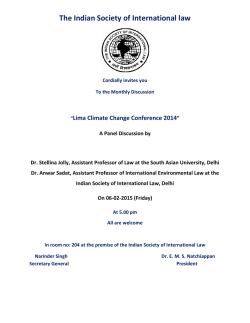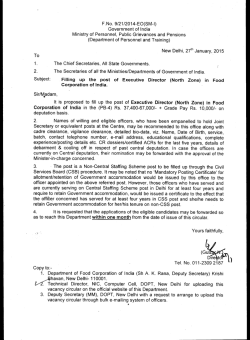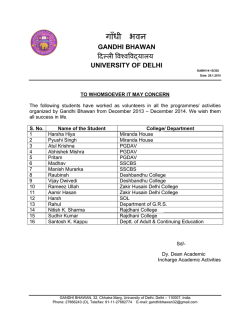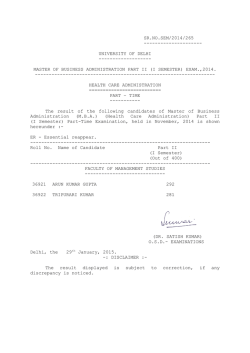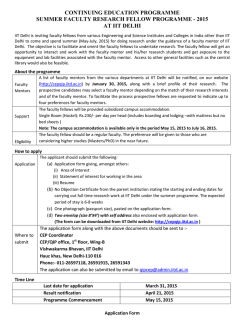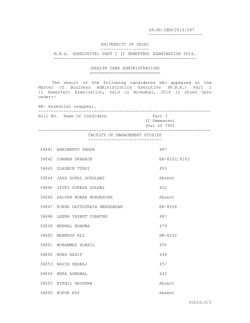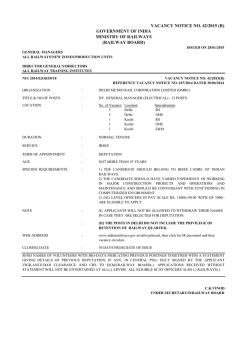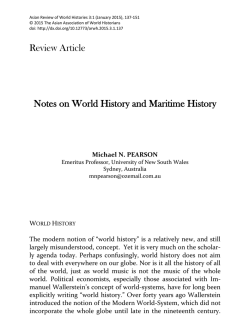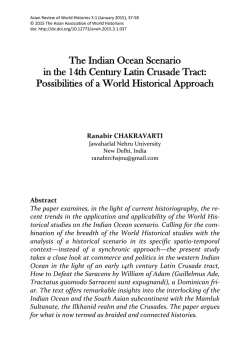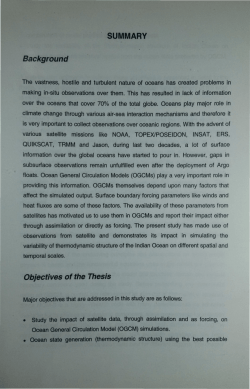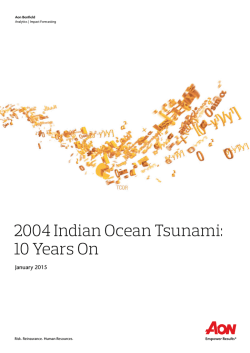
India-US Joint Strategic Vision
No. 020 – 2 February 2015 www.rsis.edu.sg RSIS Commentary is a platform to provide timely and, where appropriate, policy-relevant commentary and analysis of topical issues and contemporary developments. The views of the authors are their own and do not represent the official position of the S. Rajaratnam School of International Studies, NTU. These commentaries may be reproduced electronically or in print with prior permission from RSIS and due recognition to the author(s) and RSIS. Please email: [email protected] for feedback to the Editor RSIS Commentaries, Mr Yang Razali Kassim. India-US Joint Strategic Vision: A New Regional Role for Delhi? By Darshana M. Baruah Synopsis There appears to be a new policy direction in New Delhi’s regional security interests. The highly significant document that came out of the recent Obama visit, “US-India Joint Strategic Vision for the Asia-Pacific and Indian Ocean Region”, outlines India’s new role in the region. Commentary THE RECENTLY concluded visit by President Barack Obama to New Delhi was a significant milestone in Indo-US relations, Obama being the first American president to be the chief guest during India’s republic day celebrations. The three-day visit has been hailed as successful, strengthening Indo-US bilateral ties. The upshot is a major document called the India-US Joint Strategic Vision for the Asia-Pacific and Indian Ocean Region. While taking the bilateral relationship a step forward, what is interesting to note is that this enhanced friendship is also setting an agenda for the Asia Pacific and the Indian Ocean Region. At the outset is a bolder and more confident Indian government led by Prime Minister Narendra Modi. Joint Indo-US strategic vision The new government has chosen to shift away from its previous stance of keeping a distance on some issues. While India has always been eager to play the role of a security provider in the region, New Delhi is always conscious of the China factor. However, one can see a clear vision emerging out of the new government -- that India is ready to play a more active role in the emerging security architecture in the Indo-Pacific. Maritime security has always been a priority for New Delhi, but the Modi government is taking initiatives in charting a policy direction in this regard. While conflict in the South China Sea challenges India’s strategic and economic engagements with Southeast Asia, an increasing Chinese presence in the Indian Ocean is a direct threat to New Delhi’s sphere of strategic influence. Recognising the interlinked display of power politics in the South China Sea and the India Ocean, India’s “Look East Policy” has been transformed to the “Act East Policy” - laying the groundwork for an increased Indian presence in Southeast Asia. India’s concern regarding the territorial disputes in the South China Sea has found common ground with US interests. New Delhi has taken a step forward from the general rhetoric on “freedom of navigation” with Modi’s direct statements on the need to maintain peace and stability in the South China Sea. This shared concern was reflected during both Modi’s visit to the US in September 2014 and Obama’s visit to India in January 2015. There is a willingness in the Indian political circle to work closely with Washington on security issues in the Asia-Pacific and the Indian Ocean Region. The “US-India Joint Strategic Vision for the AsiaPacific and Indian Ocean Region”, a document released during Obama’s January visit, is an outcome of such an initiative. The adoption of the strategic vision reflects India’s much needed enthusiasm to play a greater leadership role in the region and India’s willingness to step aside from its strict “nonalignment” principle to further this vision. What it means The vision underpins the importance of economic integration and connectivity for regional security. Without naming China, the document underlines the issue of unilateral and assertive behaviour in the South China Sea affecting regional peace and security. One of the key points in the document is that both India and the US now understand the need for multilateral partnerships furthering the need for collective security in Indo-Pacific. There are three key takeaway points from the strategic vision: Firstly, the Chinese Maritime Silk Road (MSR) is a cause for major concern in New Delhi as it provides a basis for Beijing to increase its footprint in the Indian Ocean. Details and intent of the MSR are still unknown though it is being pursued to promote regional connectivity and infrastructure. Strategic implications of such a project running through the Asia-Pacific and the Indian Ocean are high for both New Delhi and Washington. It is perhaps to counter such a Chinese project that the strategic vision notes the need to support regional economic integration “in a manner that links South, Southeast and Central Asia, including by enhancing energy transmission and encouraging free trade and greater people-to-people linkages”. Secondly, freedom of navigation is an area of contention particularly between Beijing and Washington. While China acknowledges the right of free passage through its exclusive economic zone (EEZ), it disputes military activities by foreign naval vessels. Should the international community accept China’s claims in the South China Sea, navies of the world would have to seek China’s permission while operating in those waters. With the launch of New Delhi’s “Act East Policy”, freedom of navigation for both commercial and military ships is a priority for India too. It is this shared concern that has found its way into the joint statements and the strategic vision. The document on the joint strategic vision says that as “Regional prosperity depends on security”, both sides “affirm the importance of safeguarding maritime security and ensuring freedom of navigation and over- flight throughout the region, especially in the South China Sea”. Thirdly, India and the US seem to acknowledge that collective security is the best way forward in the emerging regional security architecture. Where India has before been cautious of entering into trilateral and multilateral security arrangements, New Delhi now is leading the way for such initiatives. Way forward Underlining the need for such cooperation, the document states that over the next five years, both sides “will strengthen our regional dialogues, invest in making trilateral consultations with third countries in the region more robust, deepen regional integration, strengthen regional forums, explore additional multilateral opportunities for engagement, and pursue areas where we [US and India] could build capacity in the region that bolster long-term peace and prosperity for all”. The strategic vision has helped India outline its new role in Asia-Pacific and the Indian Ocean Region. There has been a call for India to take on more regional responsibility and shoulder some of the leadership roles. Cooperation amongst the key powers of the Indo-Pacific will secure and strengthen the region’s emerging security architecture. Given the changing power dynamics and India’s own regional and global strategic interests, the Modi government seems confident and ready to take on a more active security role in the region. The writer is a Junior Fellow at the Observer Research Foundation, New Delhi and Associate Editor of the ORF South China Sea Monitor. She contributed this article to RSIS Commentary. Nanyang Technological University Block S4, Level B4, 50 Nanyang Avenue, Singapore 639798 Tel: +65 6790 6982 | Fax: +65 6794 0617 | www.rsis.edu.sg
© Copyright 2025
